
Did you know that AI-powered restaurants are experiencing a 30% increase in operational efficiency and a 25% reduction in food waste? These aren’t just impressive numbers—they represent a fundamental shift in how the food sector operates.
Table of Content
The global food delivery market is projected to reach $154.34 billion by 2023, with an annual growth rate of 10.3%. This remarkable expansion is fueled by increasing consumer demand for convenience, efficiency, and personalized experiences. As technology evolves, AI in the food industry is becoming not just a competitive advantage but the driving force behind this transformation.
From farm to table, AI in the food services is reshaping every aspect of how businesses operate. It’s redefining relationships between producers, restaurants, delivery services, and consumers. This isn’t just about robots flipping burgers—it’s about intelligent systems that enhance customer experiences, streamline operations, ensure food safety, and deliver personalization at scale.
In this comprehensive guide, we’ll explore how AI in the food industry is creating revolutionary changes that benefit businesses and customers alike. We’ll dive into real-world applications, examine success stories, and look at what the future holds for this exciting intersection of technology and gastronomy.
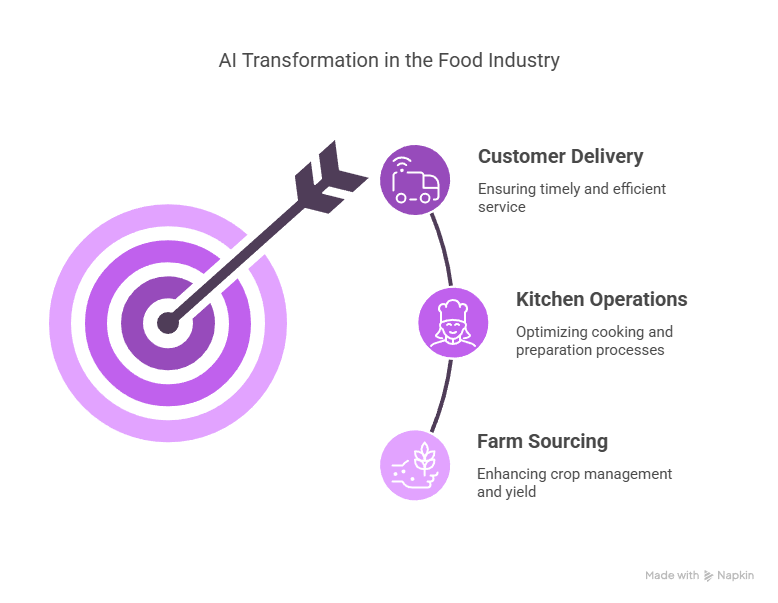
Amazon generates 35% of its revenue through AI-driven personalized recommendations. The food sector is now harnessing this same power with remarkable results.
AI in the food industry is revolutionizing how customers discover new dishes. These intelligent systems don’t just track basic preferences—they analyze over 50 different data points about each customer to create a comprehensive taste profile.
The technology considers:
A study by Deloitte found that restaurants implementing AI recommendations saw average order values increase by 18-23%. Customers appreciate the convenience of having relevant options suggested rather than scrolling through extensive menus.
Modern food delivery apps take this personalization even further by using predictive analytics to anticipate your needs before you even open the app. For instance, some systems can predict with 85% accuracy what you’ll order for Friday dinner based on your weekly patterns.

AI for food and restaurants has introduced another game-changing capability: dynamic pricing systems that operate with remarkable precision.
Much like how Uber uses surge pricing during peak hours, food delivery platforms now adjust prices in real-time based on dozens of variables:
These systems use machine learning to continuously improve pricing strategy. They identify optimal price points that balance maximum revenue with customer satisfaction and retention.
One national restaurant chain reported a 15% revenue increase after implementing AI-driven dynamic pricing during lunch rush hours. More impressively, they saw a 7% increase in customer satisfaction scores despite the variable pricing model.
The most sophisticated systems can even personalize pricing at the individual customer level, offering tailored discounts based on purchasing history and price sensitivity. This might mean offering a 10% discount to a price-sensitive customer while showing full price to another who values convenience over cost.
Food waste costs the industry a staggering $162 billion annually in the US alone. AI in the food services tackles this problem head-on through sophisticated predictive analytics that operate with unprecedented precision.
These advanced systems analyze a multitude of data points simultaneously:
Leading-edge systems incorporate deep learning algorithms that continually improve their accuracy. Some can now predict daily ingredient needs with 92-96% accuracy—a level impossible with traditional forecasting methods.
The financial impact is substantial. Restaurants using AI in the food industry for demand forecasting report:
For a mid-sized restaurant chain, this can translate to hundreds of thousands in annual savings while improving customer satisfaction through better product availability.

Manual inventory management is tedious, error-prone, and costs the average restaurant 8-10 hours of staff time weekly. AI in the food industry automates this process entirely, transforming a major pain point into a competitive advantage.
Today’s smart inventory systems continuously monitor stock levels through a multi-layered approach:
The AI doesn’t just track—it thinks. When supplies approach predetermined thresholds, the system:
For restaurant groups or chains, AI in the food services can coordinate inventory across multiple locations, automatically redistributing ingredients to avoid waste and stockouts.
One national quick-service restaurant chain implemented this technology and reduced inventory costs by 21% while completely eliminating emergency supply runs.
In food delivery, time isn’t just money—it’s the difference between a delighted customer and a disappointed one. AI in the food services optimizes delivery routes with a level of complexity and efficiency that human dispatchers simply cannot match.
These sophisticated systems process billions of calculations per second, considering:
The most advanced systems employ machine learning algorithms that continuously improve routing efficiency based on actual delivery outcomes. They learn from each delivery, identifying patterns that even experienced drivers might miss.
According to McKinsey’s comprehensive logistics study, AI in the food industry reduces fuel costs by 10-15% and delivery times by 20-30%. For high-volume operations, this translates to hundreds of thousands in annual savings.
A leading food delivery platform implemented AI route optimization and saw:
For food delivery businesses, these improvements mean hotter food, happier customers, more orders per hour, and substantially better economics.
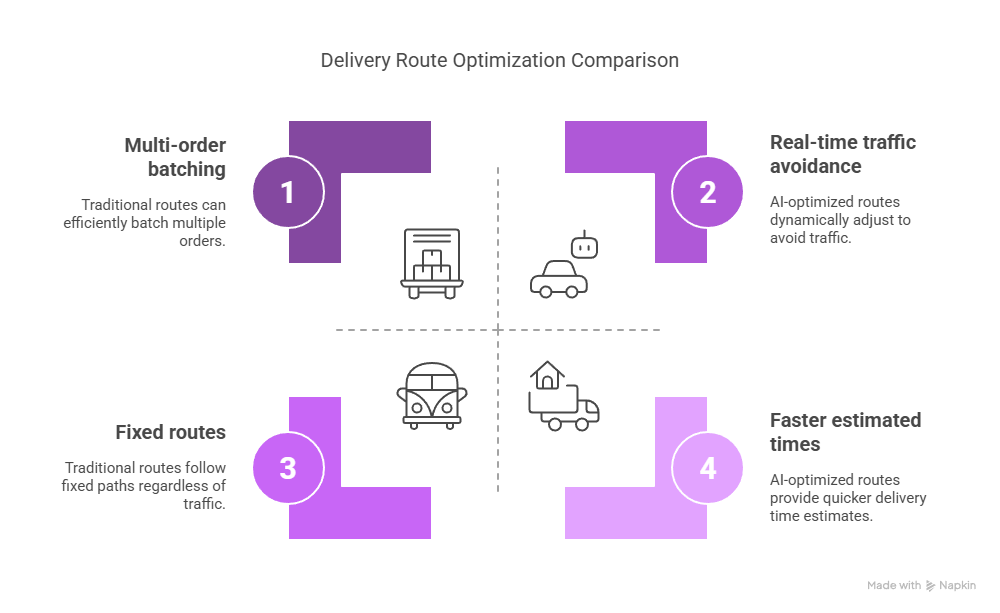
Nothing frustrates customers more than inaccurate delivery estimates. Studies show that 82% of consumers consider delivery time accuracy more important than delivery speed. AI in the food industry solves this problem through multi-variable predictive analytics.
Traditional systems use simplistic distance-based calculations that fail to account for real-world complexity. Modern AI delivery prediction engines consider over 30 variables:
These factors combine within sophisticated neural networks to create delivery time predictions that are accurate within 2-3 minutes. This precision builds customer trust and reduces “where’s my order?” support calls by up to 45%.
One major pizza chain implemented AI in the food services delivery predictions and saw:
Perhaps most importantly, the system communicates any delays immediately to customers, providing updated arrival times and transparency that significantly improves the experience even when delays occur.
Food safety isn’t just about regulations—it’s about customer trust and brand reputation. A single foodborne illness incident can cost a restaurant an average of $75,000 in direct costs and far more in lost business. AI in the food services provides unprecedented monitoring capabilities that transform quality control from periodic sampling to continuous assurance.
Today’s advanced computer vision systems integrate multiple technologies:
These systems can:
A leading quick-service restaurant implemented AI in the food industry quality monitoring and reported:
These AI systems work 24/7 without fatigue, maintaining constant vigilance over food quality while generating comprehensive documentation that simplifies regulatory compliance.
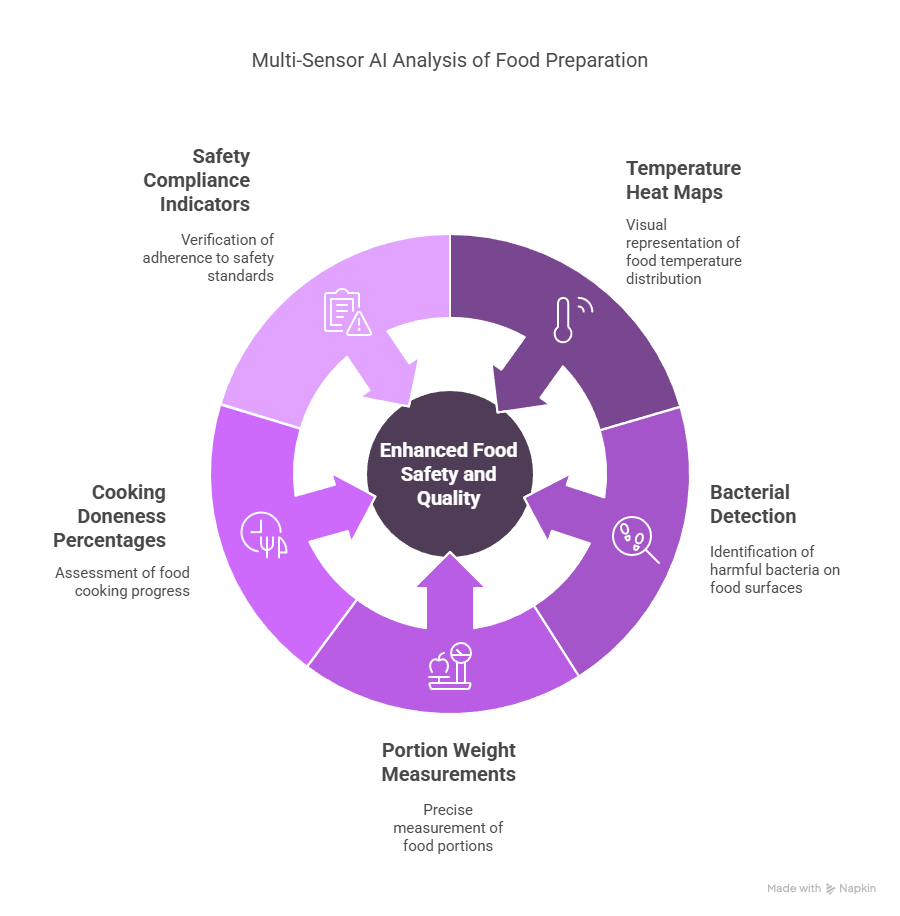
Food safety begins with proper sanitation. The CDC estimates that proper hygiene practices could prevent 20% of foodborne illnesses, yet traditional monitoring methods are inconsistent and labor-intensive. AI for food and restaurants is transforming how businesses monitor hygiene with remarkable precision.
Smart camera systems equipped with specialized AI algorithms can:
These systems don’t just observe—they analyze and learn. The AI identifies patterns that correlate with inspection failures and builds predictive models to prevent issues before they occur.
One national restaurant chain implemented AI in the food services hygiene monitoring across 340 locations and achieved:
The technology also automatically generates comprehensive compliance reports, documenting every aspect of hygiene practices throughout the day. This documentation not only helps restaurants maintain the highest standards but provides invaluable protection during official inspections and audits.
Most importantly, staff quickly adapt to the monitoring, developing better habits that persist even when they work in locations without the technology.
Customer service can make or break food businesses. Studies show that 70% of customers abandon a purchase if they can’t get help within 5 minutes. AI in the food industry addresses this challenge through intelligent chatbots that provide instant, personalized service at scale.
Today’s sophisticated food service chatbots utilize:
These virtual assistants can:
A leading fast-casual restaurant chain implementing AI in the food services chatbots reported:
The technology has advanced so far that in blind tests, over 70% of customers couldn’t reliably distinguish between AI assistants and human agents. The most sophisticated systems use voice modulation that includes natural pauses, “umms,” and slight variations in pace that mimic human speech patterns.
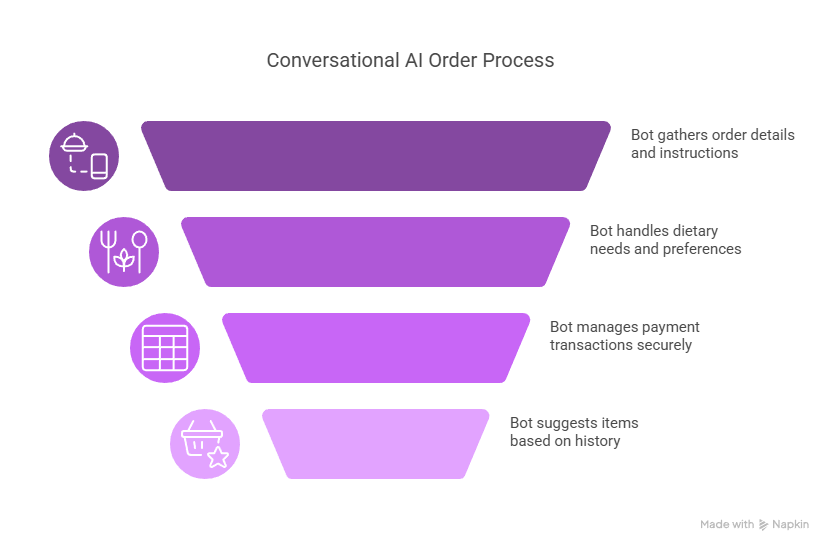
AI in the food services is making ordering more convenient and accessible through sophisticated voice recognition technology that understands natural speech patterns, dialects, and even noisy backgrounds.
The market for voice-based food ordering is exploding, with projections indicating it will account for over $10 billion in food sales by 2026—a 400% increase from current levels.
Customers can now place orders through multiple voice-enabled channels:
The best systems employ contextual AI that remembers your preferences and understands natural language. Rather than requiring specific phrasing like “add large pepperoni pizza,” customers can say things like “I’d like my usual pizza but with extra cheese this time” and the system understands the reference.
A national pizza chain implementing AI in the food industry voice ordering technology reported:
This technology removes friction from the ordering process and makes food services accessible to those with disabilities, limited dexterity, or visual impairments. It’s particularly valuable for customers who are multitasking—cooking, driving, or caring for children—who can place orders without stopping their primary activity.
What are customers really saying about your food business? Traditional feedback methods capture only 4% of customer dissatisfaction—the rest remains hidden but impacts future purchase decisions. AI in the food industry solves this challenge by analyzing vast amounts of feedback across channels using advanced natural language processing.
These sophisticated systems process multiple data streams simultaneously:
Modern sentiment analysis goes far beyond simple positive/negative classification. Today’s AI in the food services uses:
The business impact is significant. Restaurants using AI sentiment analysis have improved their online ratings by an average of 1.3 stars within six months—a difference that can increase revenue by 5-9% according to Harvard Business School research.
A national burger chain implemented AI in the food industry sentiment analysis and discovered that 47% of negative reviews mentioned a specific sauce being discontinued—information that wasn’t surfacing through traditional feedback channels. After reintroducing the sauce, satisfaction scores increased by 23%.
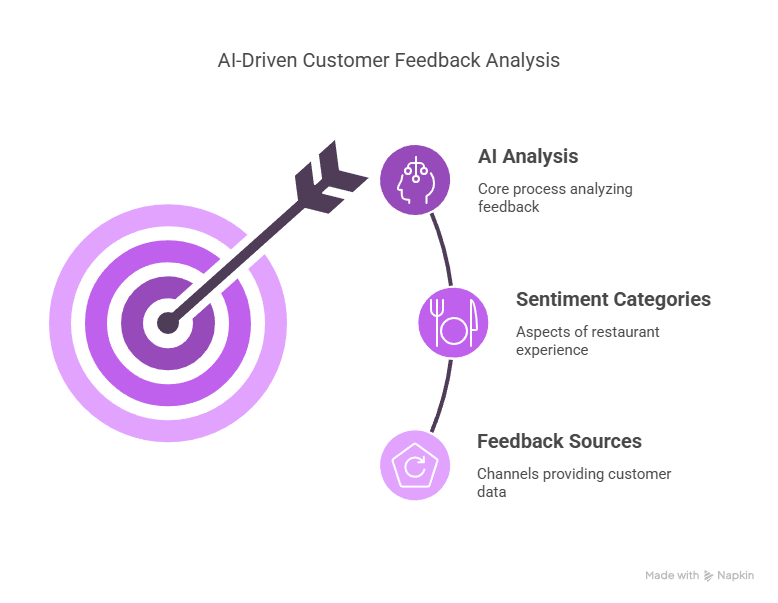
Traditional loyalty programs generate diminishing returns—80% of program members are inactive according to research by Bond Brand Loyalty. AI for food and restaurants transforms this dynamic by creating hyper-personalized retention strategies that evolve with each customer interaction.
Instead of offering the same generic rewards to everyone, AI loyalty systems:
The technology uses sophisticated machine learning algorithms that continuously refine their understanding of each customer. Rather than static rules, the system adapts rewards in real-time based on changing behaviors and preferences.
One fast-casual chain implemented AI in the food services loyalty program and achieved remarkable results:
The most advanced systems incorporate predictive analytics that identify when regular customers deviate from their normal patterns—a prime indicator of potential churn. The AI then automatically triggers recovery campaigns with personalized offers designed specifically to re-engage that individual based on their unique preferences and history.
Rather than generic “We miss you!” messages, the system might send “We noticed you haven’t ordered your favorite Tuesday night family meal recently. Here’s 30% off your usual order for next Tuesday.”
-time cooking analytics, inventory levels, and order prioritization*
Creating a profitable menu requires both culinary creativity and business savvy. AI in the food industry balances both perfectly.
AI menu engineering analyzes:
Restaurants using AI menu optimization report average profit increases of 15-20% without raising prices.
The system might suggest removing poorly performing items, repositioning others, or creating new combinations based on customer preferences.
AI in the food services extends beyond restaurants to the very beginning of the supply chain.
Smart farming technologies include:
These innovations ensure restaurants receive the freshest, highest-quality ingredients precisely when needed.
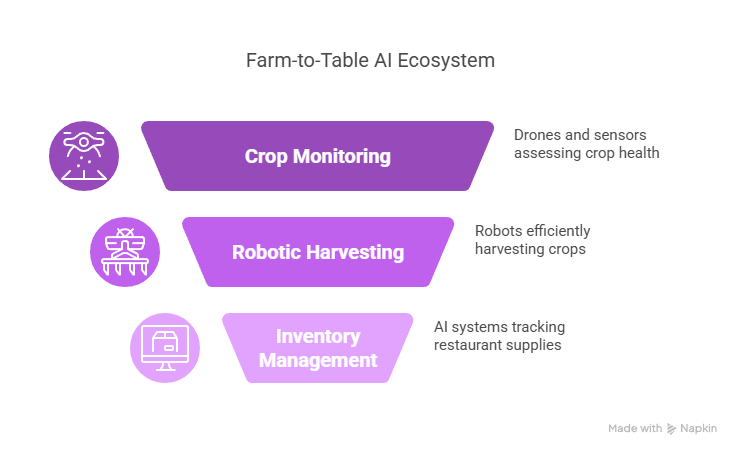
Between farm and restaurant, AI for food and restaurants transforms processing operations.
Modern facilities employ:
These systems ensure consistent quality while reducing labor costs and minimizing waste throughout the supply chain.
Sustainability is increasingly important to consumers. AI in the food industry offers powerful tools to reduce environmental impact.
AI-powered sustainability initiatives include:
Restaurants implementing AI waste reduction report 30-40% less food waste within months of adoption.
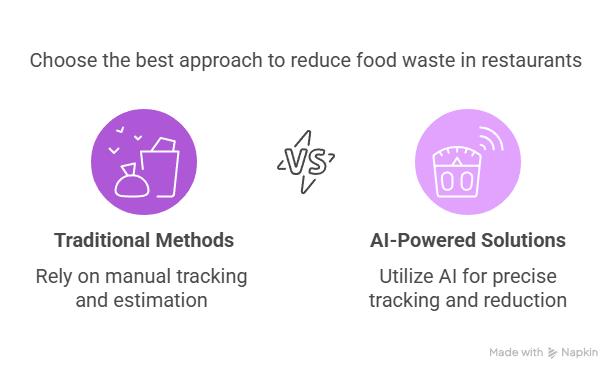
AI in the food services helps businesses understand and reduce their environmental impact.
These systems calculate carbon footprints by analyzing:
The AI then recommends actionable steps to reduce emissions while maintaining quality and profitability.
Several restaurant chains have achieved carbon neutrality by following AI-generated sustainability roadmaps.
The evolution of AI in the food industry continues at a rapid pace. Several transformative technologies are just emerging:
These innovations will further reshape how food businesses operate over the next decade.

As AI for food and restaurants advances, the most successful implementations will balance technology with human creativity.
The future lies not in replacing chefs and servers but in augmenting their capabilities:
This balanced approach delivers the best of both worlds—efficiency and warmth, precision and creativity.
At Code Brew Labs, we specialize in developing cutting-edge AI in the food services solutions that transform operations and experiences.
Our team brings deep expertise in:
We’ve helped dozens of food businesses leverage the power of AI in the food industry to boost efficiency and customer satisfaction.
Every food business is unique. Code Brew Labs designs customized AI for food and restaurants that addresses your specific challenges.
Whether you need:
Our solutions are built specifically for your business model, customer base, and growth objectives.
The food industry is evolving rapidly. Businesses that embrace AI in the food services gain a significant competitive advantage.
Contact Code Brew Labs today to explore how our AI-powered solutions can help you stay ahead of the competition in the food and restaurant industry.
Let’s create a future where technology enhances every aspect of the food experience—from farm to kitchen to table to feedback.
